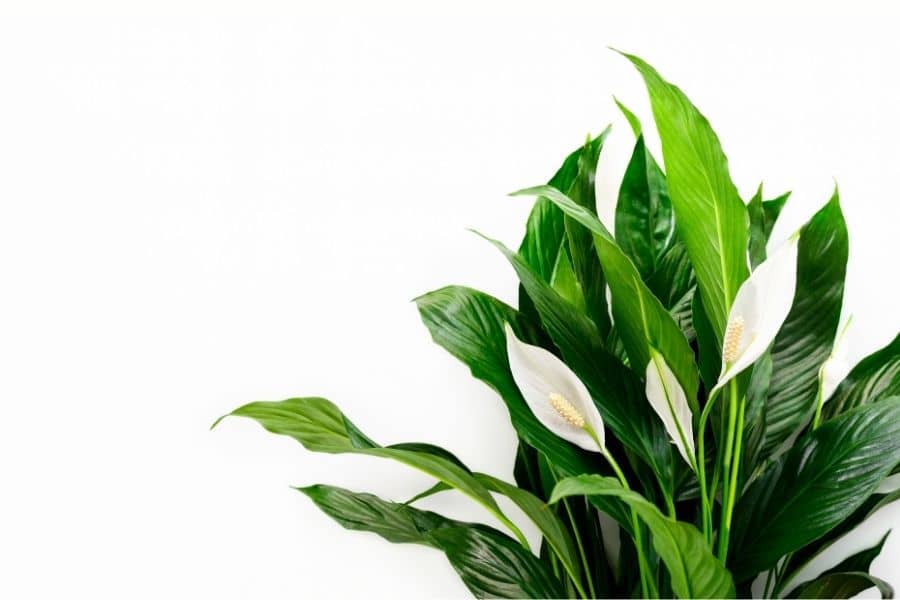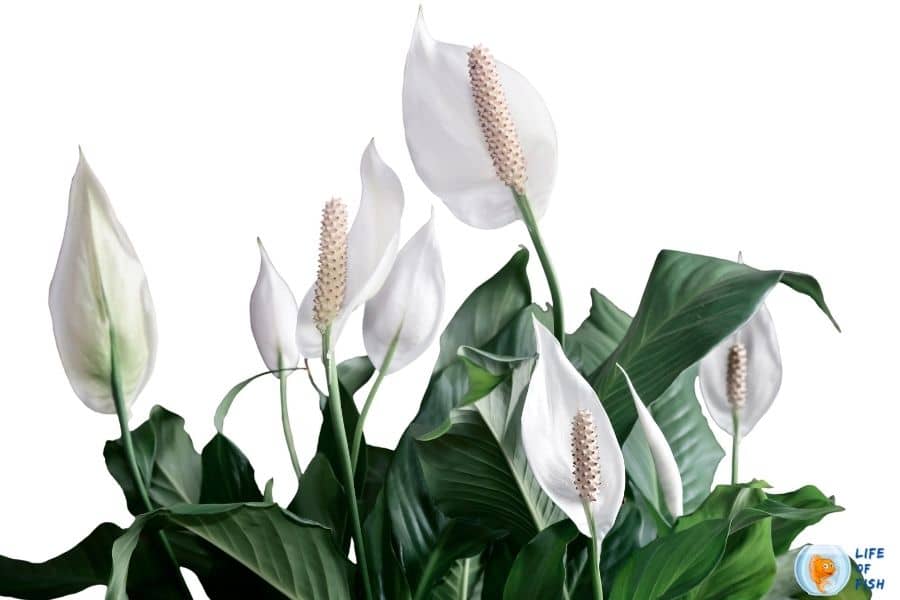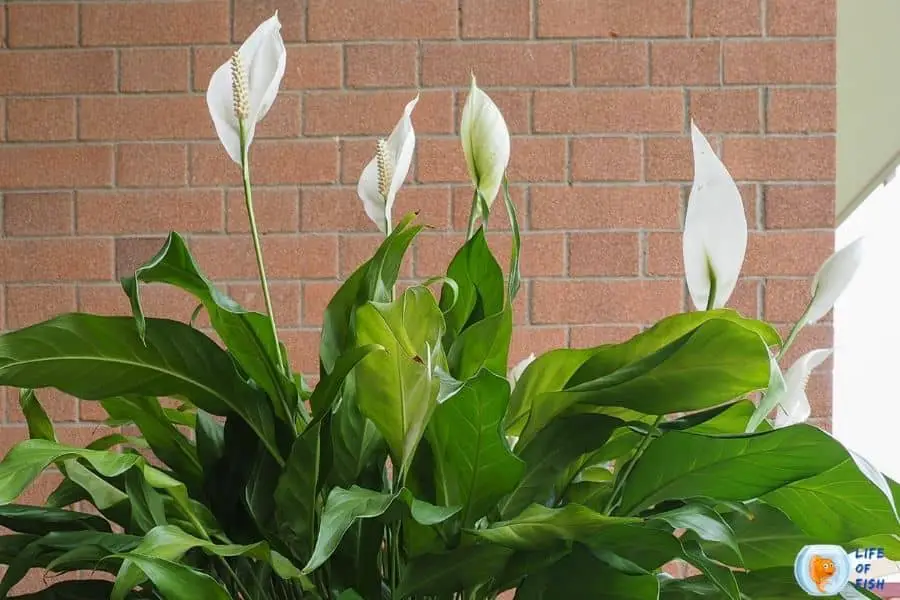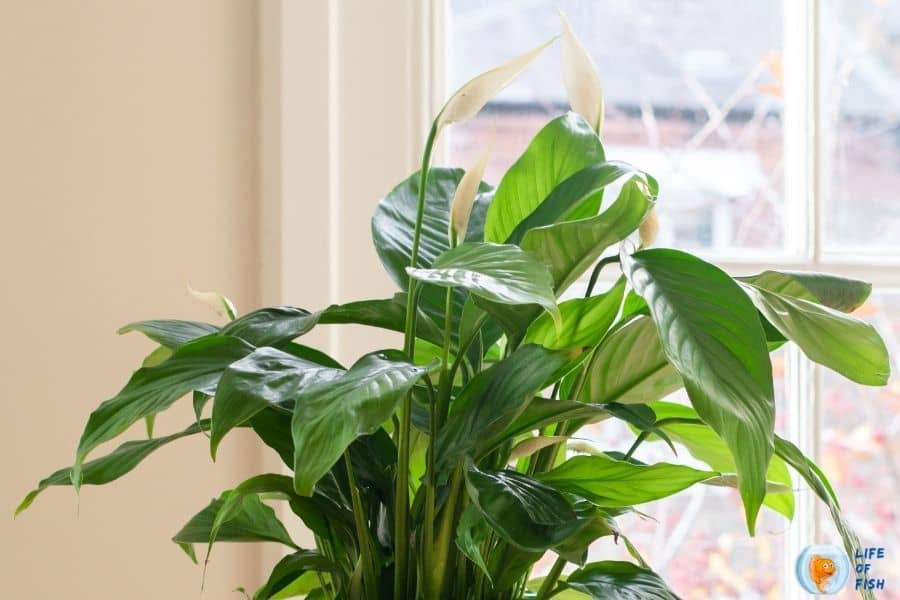Peace Lily is a common houseplant popular in offices and homes. It is not an actual aquatic plant, but you can grow them successfully in aquariums when appropriately maintained.

What is Peace Lily?
Jump To
- 1 What is Peace Lily?
- 2 How to identify them?
- 3 Is peace lily aquatic?
- 4 Peace lily plant benefits
- 5 Can I submerge a peace lily in water?
- 6 How long can a Peace lily live in water?
- 7 How do I put peace lily in aquarium?
- 8 Can peace lily be propagated?
- 9 Are aquarium peace lilies toxic to fish?
- 10 How to put a peace lily in a betta fish bowl?
- 11 How do I know if my peace lily has root rot?
- 12 Why are the tips of my peace lily turning brown?
- 13 Why do aquarium peace lilies turn yellow?
- 14 How much does a peace lily cost?
The scientific name for peace lily is Spathiphyllum. It is an adaptable and low-maintenance houseplant native to tropical rain forests in America.
Peace lilies thrive in warm and humid conditions and bloom white to off-white flowers starting from the summer and throughout the year when given ideal conditions.
Peace Lillies are not true lilies, but the flowers resemble calla lilies. Therefore, it got the name “peace lily.”
How to identify them?
Actually, the Spathiphyllum plant has many varieties, and most varieties grow about one to three feet in height and width.
However, almost all the varieties share the same shape and color, which is described below.
Peace Lily plant has dark green shiny, lance-shaped leaves. It occasionally blooms unusual but beautiful flowers.
The color of this flower varies according to the Peace Lilly type. Usually, the color varies from pure white to off-white.
The true flower of this plant is the spadix which comes in white to pale yellow color. It is covered with white spathe or bract.
This spathe is the most noticeable part of this plant, and most people misjudge it as the “flower.”
As this is a terrarium plant, it prefers moist soil with good drainage. If you submerge this attractive plant in water, the plant will rot and die.
It needs bright, filtered light to thrive and will do fine without any fertilizers.
The flowers usually bloom in the spring. And it will bloom again in the fall if the plant is well cared for.
These flowers will stay alive for about two months and then fade. After these blooms fade, a period of non-blooming follows.
On average, well-cared peace lily plants survive for about 3 to 5 years. In addition, the propagation of this plant is easy.
You can propagate this plant by dividing the plant and growing separately in different containers. Further, you can do this propagation in any season.

Is peace lily aquatic?
Peace Lily is not an aquatic plant. It is a terrarium plant. But, it can survive in an aquatic environment for a long time if only roots are submerged and the leaves emerge.
Can you put a peace lily in a fish tank?
Since Peace Lily can survive in water only when the roots are submerged, you can put this attractive plant in a fish tank.
Peace Lily can stay in water for a prolonged period of time when only roots are in the water and all other parts in the air.
Keep in mind that it is mildly toxic to mammals because it has a toxic sap containing calcium oxide.
Although there are no proven reports of Calcium oxalate being poisonous for fish, it is better to keep plant-eater fish away from the Peace Lily plant.
Peace lily plant benefits
Growing this plant indoors have many benefits for us (and fish when grown in an aquarium).
They purify the air
Although we don’t realize it, our homes contain more pollutants in the air, which cause a lot of health issues.
House plants like Peace lily are also called cobra plants because they can absorb these pollutants and purify the air.
According to a NASA experiment, Peace Lily can absorb harmful chemicals like benzene, xylene, carbon monoxide, and formaldehyde from its surroundings.
It can eliminate about 60% of pollutants by absorbing, and in return, this plant adds moisture to the air to make the atmosphere suitable for breathing.
low maintenance
It is generally hard to accommodate time for plant maintenance with our busy schedules.
Some plants require careful maintenance with daily watering to survive. But Peace Lilies thrive without water for days.
So, you don’t have to worry about your plant if you often forget to water the plant. this plant does better without direct sunlight.
So, anywhere near the window is good to go with this plant. If you grow it in a fish tank, you don’t need watering at all.
It will thrive for itself without much care by you. Therefore, many indoor plant growers prefer to grow Peace Lily than other plant types.
Absorbs Acetone vapors
Many products you use at home contain acetone and alcohol that produce acetone vapor, which is not good for your health ( Varnishes, paints, rubbing alcohol, nail polish remover, etc.).
These vapors may cause headaches, low blood pressure, lack of coordination, acetone poisoning, and lethargy.
Peace Lily absorbs these Acetone vapors and cleans the air, making it healthy for you.
Absorbs Nutrients in the water
Peace Lily requires some nutrients to thrive. When you grow this plant in an aquarium, the plant takes nutrition through the water.
The water contains nutrients made by fish poop and they clean the water for the fish. This way peace lilies help to reduce algae growth in the tank.
Provide Shelter for Fish
Submerged established roots of the plant provide shade, hiding spots, and breeding space for fish when grown in an aquarium.
Can I submerge a peace lily in water?
No. You can not submerge it in water. If you immerse any part of this plant except for roots, the plant will rot and die.
How long can a Peace lily live in water?
Peace Lilies can survive up to one year in water. After that, it will turn yellow and eventually die.
However, you can extend its life by repotting the plant in soil when you see yellowing of the plant.

How do I put peace lily in aquarium?
Putting a Peace Lilly plant needs some setting up in your aquarium as it can not survive the underwater environment.
For this, you have to prepare an improvised wise frame that can hold on the top of the aquarium while holding the plant on the other side. Then follow these steps.
- Division the plant for the size you prefer. Cut off any dried leaves and roots.
- Rinse the whole plant in running water to remove all traces of soil.
- Set up the wireframe on the aquarium as per your choice.
- Put the washed plant inside of the housing of the wireframe. And you are done.
Can peace lily be propagated?
Peace Lily propagation is easy. When the plant grows with several leaves, divide the plant from the roots and repot the two parts in separate containers.
After some days, two plants will start to grow new leaves on their new territory.
Are aquarium peace lilies toxic to fish?
There are no confirmed cases of Peace Lillies being toxic to fish.
Most aquarists even had success growing Peace Lilies in their aquariums with plant-eater fish.
However, it is advised to avoid housing plant-eater fish with peace lilies because the plant contains Calcium Oxalate in its saps.
How to put a peace lily in a betta fish bowl?
To put a Peace Lilly into a fish bowl , you will have to fix an anchor to hold the plant on the top of the bowl.
A wired structure or a plastic plant tray will work fine when adjusted. Then, you have to rinse the plant under running water to remove all traces of soil.
When fixing the plant on the bowl, keep in mind that Betta fish need to breathe oxygen from the water surface (as these are labyrinth fish).
So, you have to leave a considerable open space on the surface.
Do bettas eat peace lily roots?
Betta fish are primarily carnivore species. If you feed them well, they will not bother eating any plant matter.
However, if you let them starve in the bowl, the Betta will start to pick the roots for nourishment.
How do I know if my peace lily has root rot?
The most likely cause of root rot is fungi infestations. When the root of the Peace Lily plant is rotted, the plant’s leaves will turn yellow and have a wilted appearance.
The most effective way to fix this problem is to trim off the affected or dead roots. You should then disinfect the remaining roots with a fungicide solution before repotting.
Why are the tips of my peace lily turning brown?
There are several reasons for this issue. But most likely, the reason for brown tips on Peace Lily is poor irrigation.
The leaves may turn brown if you overwater it or do not water it enough. Over-fertilizing may also cause brown tips on Peace Lily leaves.
And also, if the plant is exposed to direct sunlight, it may also cause drying of peace lily leaves.
However, sometimes this can be normal due to spent flowers and leaves. In this case, just cut off these spent flowers and leaves, and the plant will generally grow as it would.

Why do aquarium peace lilies turn yellow?
If your Peace Lily plant is turning yellow, it indicates a problem. There can be several reasons for this issue. The most common reasons are,
- Aging Leaves – This is actually not a problem. When the leaves age, they naturally turn yellow and eventually fall off. Cutting the leaves will resolve the issue.
- Too Much Or Too Little Light – Peace Lilies prefer indirect sunlight. If it gets too much or too little light, the leaves will start to turn yellow.
- Low Temperatures Or Drafts – Optimum temperature for Peace Lilies is about 65-85°F. These plants can not tolerate temperatures below 45°F. In case the temperature drops to this level, the leaves will turn yellow.
- Nutrient Deficiency – Although these plants do not require fertilizers to thrive, they need nutrients like Nitrogen, Magnesium, and Iron to grow healthy. The short supply of these nutrients may lead to yellow leaves on Peace lily.
- Too Much Water – When the drainage is poor, too much watering may cause root rot by preventing oxygen delivery to the roots. When this happens, the leaves will also turn yellow.
- Transplant Shock – Sometimes, when dividing and repotting the plant, it may shock their system, causing yellowing of the leaves. To minimize this, you can transplant in the springtime, which is the beginning of their growing season.
- Pests – Peace Lilies usually don’t attract pests. But, they are not immune to pests either. Bugs like spider mites, aphids, and mealybugs infest these plants, sometimes causing yellowing of leaves.
- Underwatering – Although these plants can go for several days without water, they start to wilt when they need water. When this happens, the damaged leaves of the plant will turn yellow. In this case, you simply have to cut off these damaged leaves and start watering again.
- Water Quality Issues – Peace Lillies are a bit sensitive to chlorine. So, if your tap water is chlorinated, the leaves may turn yellow. Letting the water sit overnight or using a dechlorinator will resolve this issue.
- Disease – Just like any other plant type, Peace Lilies are prone to diseases. Diseases like Cylindrocladium spathyphylli and Phytophthora parasitica have no possible cures, and if your plant is infected, it will die.
How much does a peace lily cost?
Young peace Lily plants about 10 inches long will cost you about $25, while mature plants that are longer than 12 inches will range between $50 and $150.
Read Next: 21 Beautiful Floating Aquarium Plants And Care Guide
